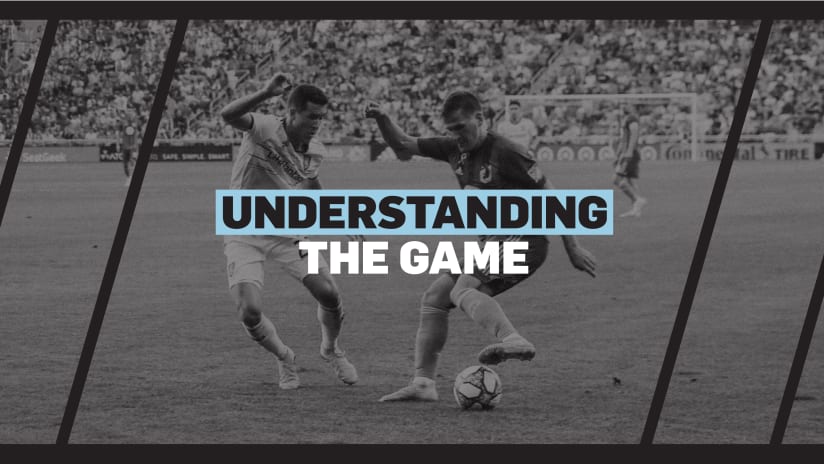Since we’ve got a bit of time on our hands, we thought it would be a good time to relax, have a little fun and stretch out a bit with some posts beyond the usual recaps, preview and interviews. In our last Understanding the Game post, we went into the basic rules of the game and touched on formations and the offside rule. Here, we’ll go a little more in-depth on a particular tactical wrinkle that’s widespread in MLS today, overlapping the fullbacks.
Ten years ago, the most common formation to find soccer teams in was the 4-4-2. It was so widespread that an entire magazine took its name — FourFourTwo — from it. Today, though, you’re much more likely to see teams in a 4-2-3-1, a system prized for its flexibility. Before we get into the particular element we’re concerned with today, let’s go over some of its general characteristics.
Given the extent to which modern football is built around finding gaps in coverage, the properly played 4-2-3-1 is valued because it provides so few gaps. With five midfielders arrayed in two waves through the middle of the pitch, it can be very difficult to break down. Having three of those midfielders dedicated to attacking roles gives a great deal of options in the final third: the center forward can drop back to hold up, the wingers can pinch in and play inverted or as second strikers, the player in the no. 10 role in the middle of the three attacking midfielders can find gaps in the defense and pick out runners.
The downsides are relatively easy to explain but often difficult to overcome. The simplest and most obvious is that if the attacking midfielders are either forced to defend more or can’t get deep enough, the lone forward can end up on an island, effectively neutralized. And then overall, the system simply requires a lot of work and a lot of coordination as players have to balance attack and defense more than in some simpler schemes.
But let’s dig into one specific virtue of the formation: the ability to transition smoothly from offense to defense and back. The key here is the double pivot — the two midfielders between the backline and the attacking mids. In Minnesota United’s case, this is Osvaldo Alonso as the holding or defensive midfielder and Jan Gregus as the central midfielder. As the names imply, this generally means that Gregus is higher up the pitch than Alonso, but the two also interchange frequently enough that no one name covers everything they do.
What concerns us here, though, is how Alonso in particular works in concert with the fullbacks when the team has the ball. A major component of creating opportunities on offense through possession is outnumbering the opposing team in critical areas of the pitch and to that end, the 4-2-3-1 allows for the outside defenders on the backline to push up into the attack. For Minnesota United, this means either Chase Gasper on the left or Romain Metanire on the right getting up the pitch in an overlap while the winger tucks in or else interchanges with them. This is usually a way to overload the box with attackers so the fullback can cross it in to three or four targets, but sometimes, crosses from overlapping fullbacks can turn into shots.
The problem with overloading a side in this way is that it can leave the team vulnerable at the back. To protect against this, Alonso will drop between the centerbacks (Ike Opara and Michael Boxall), either forming a back four (if the fullback on the opposite side of the field stays home) or a back three (if they both push up — a less conservative option). In the former case, the formation fluidly shifts to something more like a 4-1-4-1, with Gregus as the lone central midfielder and one of the fullbacks pushed up into the midfield. In theory, this should create massive problems against teams playing a 4-3-3 with three midfielders — forcing three to defend four at the edge of the final third — or else punish a 4-2-3-1 where the opposing fullbacks are likewise pushed up.
In some extreme cases with MNUFC, we’ve even seen the centerbacks make overlapping forays deep into enemy territory, often when looking to push for an equalizer or a go-ahead goal or against teams such as the San Jose Earthquakes, who employ an aggressive man-marking scheme that can lead to mismatches deep-lying defenders can exploit. Those kinds of runs, though, are entirely dependent on the team’s confidence in Alonso’s ability to erase mistakes, which has absolutely been earned. His talent for snuffing out counters and almost singlehandedly owning the middle of his team's defensive end is what made him a legend in Seattle.
What this all points to, though, is how formations as a collection of numbers that dictate how the team plays are both less and more important than we generally think. The way a soccer team works together is less like an orchestra — where certain chairs play certain parts and everything is minutely arranged for maximum execution — and more like a Southern rock band with a couple drummers, multiple lead guitar players and a bassist who can occasionally sing lead. Gregg Allman was a better lead singer than Berry Oakley as surely as Luis Amarilla is a better scorer than Michael Boxall, but there’s a reason Oakley sang lead on “Hoochie Coochie Man.” Players who have developed chemistry can stay nimble and switch things up so they’re not just throwing out the same look every time out. Generally, the great musical improvisers — your Duane Allmans, your Dickey Bettses — aren’t creating things from scratch. The songs are a structure that allows for creativity.
Formations work in much the same way. Yes, the numbers mean something, but they're not a set of rules. They provide the scaffolding for players to execute bits of improvisation based on agreed upon changes like overlapping the fullbacks and dropping the defensive midfielder. Two teams can play the same 4-2-3-1 in very different ways, and that’s the beauty of it.





